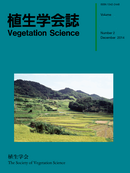Volume 22, Issue 2
Displaying 1-6 of 6 articles from this issue
- |<
- <
- 1
- >
- >|
-
Article type: Article
2005 Volume 22 Issue 2 Pages 71-86
Published: December 25, 2005
Released on J-STAGE: January 06, 2017
Download PDF (1820K) -
Article type: Article
2005 Volume 22 Issue 2 Pages 87-102
Published: December 25, 2005
Released on J-STAGE: January 06, 2017
Download PDF (1913K) -
Article type: Article
2005 Volume 22 Issue 2 Pages 103-111
Published: December 25, 2005
Released on J-STAGE: January 06, 2017
Download PDF (3713K) -
Article type: Article
2005 Volume 22 Issue 2 Pages 113-133
Published: December 25, 2005
Released on J-STAGE: January 06, 2017
Download PDF (3035K) -
Article type: Article
2005 Volume 22 Issue 2 Pages 135-146
Published: December 25, 2005
Released on J-STAGE: January 06, 2017
Download PDF (1824K)
-
Article type: Article
2005 Volume 22 Issue 2 Pages 147-152
Published: December 25, 2005
Released on J-STAGE: January 06, 2017
Download PDF (647K)
- |<
- <
- 1
- >
- >|
